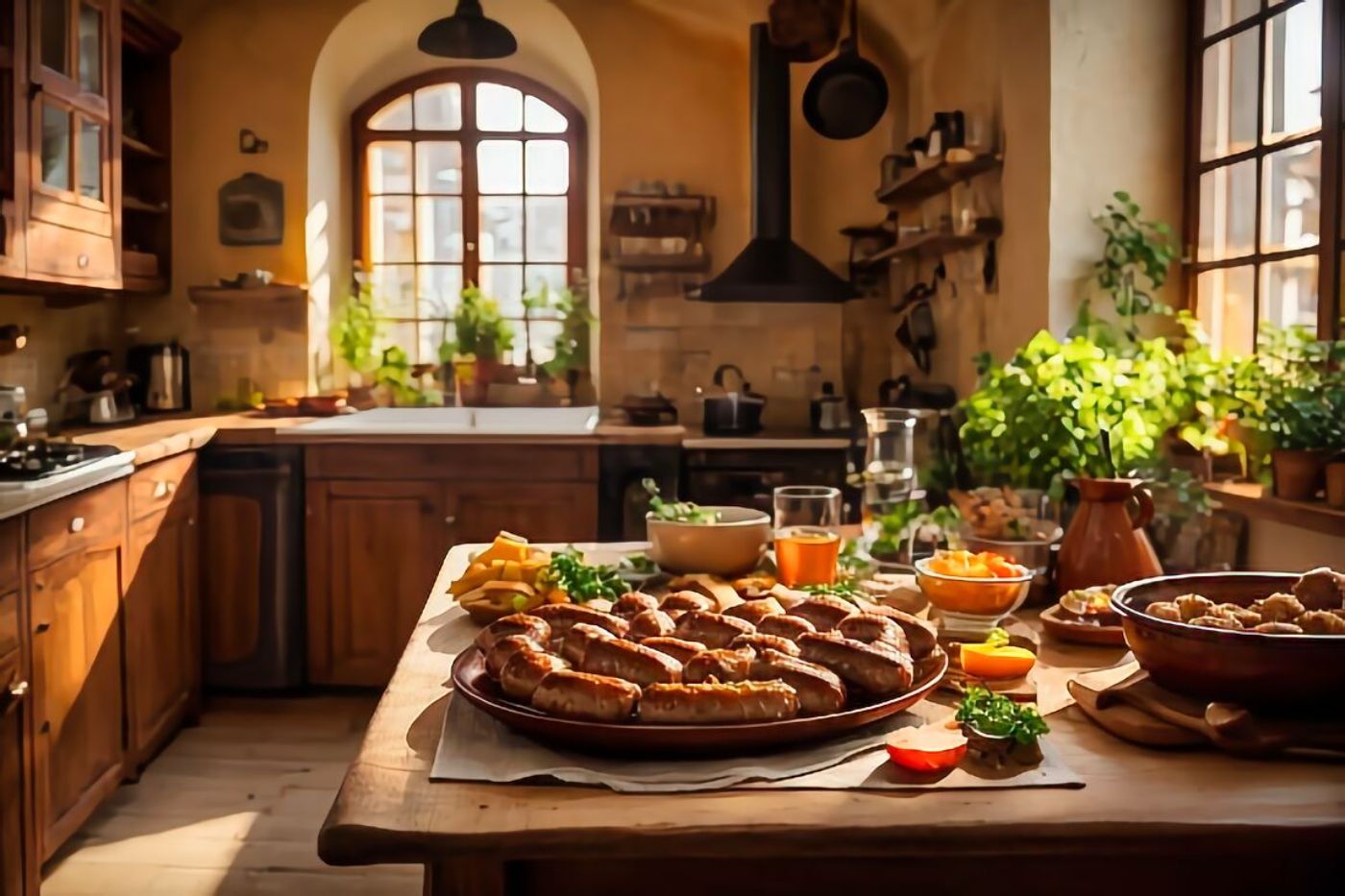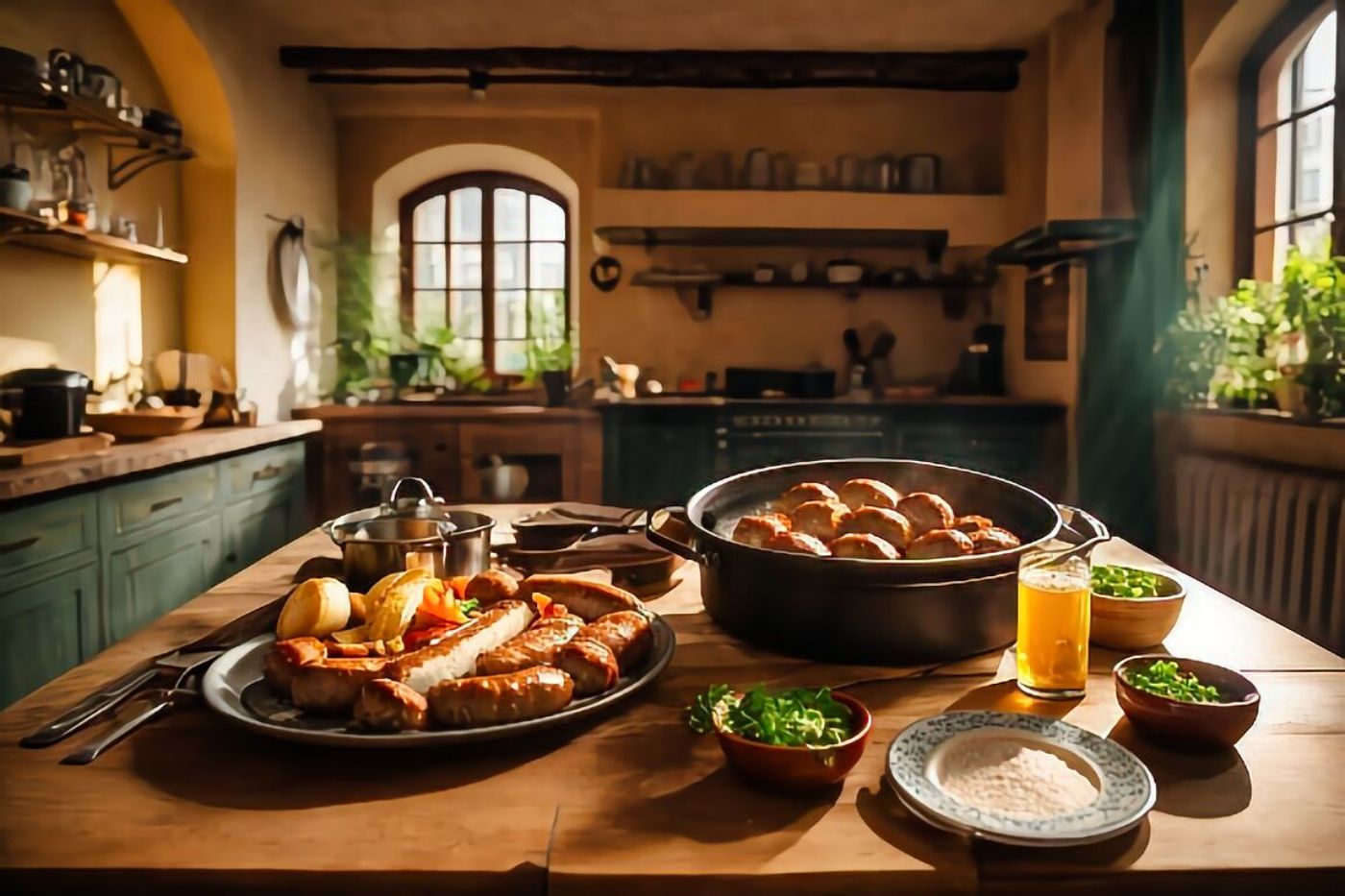
The Homemade German Bratwurst Recipe is a traditional German dish that involves the preparation of sausages. These sausages are renowned for their rich, savory flavor and are often enjoyed at gatherings and celebrations. They are typically made using a blend of minced pork or veal mixed with various spices for a unique taste. The sausages are then encased in natural casings, which are usually made from the intestines of animals. The Homemade German Bratwurst Recipe is an essential part of German culinary heritage and has a history dating back centuries.
Want more ideas for Your German Recipe Box?
A lot of great options are in these posts!
24 Traditional German Recipes/a>
You May Want to Join The World Recipes With Our Big Escape
Share your own recipes in our Facebook Group. Find recipes from all over the world. Learn more about International Cuisine and how you can surprise your family with new and exciting foods from all over the world.
For More Photos Visit Our Instagram at World Recipes Daily
Germany Food History:
The culinary history of Germany is steeped in tradition and has evolved over the years. Germany has a diverse range of regional dishes, each with its own unique flavors and ingredients. Traditional German cuisine reflects the agricultural nature of the country, with hearty and filling dishes. Over the centuries, German cuisine has been influenced by neighboring countries, resulting in a blend of flavors and cooking techniques.
Modern Food vs Historic Food:
Compare Historic Germany Food to Modern Germany Food and its evolution:
Historically, German food was primarily based on locally available ingredients. It featured ingredients such as pork, potatoes, sauerkraut, and various bread types. These ingredients were used to create comforting and filling meals. However, as Germany became more connected to the global food market, its cuisine evolved. Modern German cuisine incorporates a wider variety of ingredients, including international flavors and influences.
Homemade German Bratwurst Recipe Health Benefits:
The Homemade German Bratwurst Recipe, when prepared with lean meats and minimal additives, can offer some health benefits. Pork, a common ingredient in bratwurst, is a good source of protein. It also contains essential vitamins and minerals, including vitamin B12, zinc, and selenium. However, it’s important to note that bratwurst can be high in saturated fats and sodium, which should be consumed in moderation.
In summary, the Homemade German Bratwurst Recipe is a traditional German dish known for its savory sausages. Germany’s food history is rich and varied, with a mix of regional dishes influenced by neighboring countries. Modern German cuisine has evolved to include a wider range of ingredients and flavors. While the Homemade German Bratwurst Recipe can provide protein and essential nutrients, it should be enjoyed in moderation due to its potential for high saturated fats and sodium content.

How To Make Our Homemade German Bratwurst Recipe
Ingredients (8 Servings)
For the Sausage
7.5 lbs boneless pork shoulder (can substitute part veal if desired) , cut into 1/2 inch pieces and put in freezer for 45 minutes prior to grinding
36 ounces pork back fat , cut into 1/2 inch chunks and put in freezer for 45 minutes prior to grinding
6 cups crushed ice
For the Spice Mixture:
4 1/2 tablespoons salt
3/4 cup dried milk powder
4 1/2 teaspoons freshly ground white pepper
2 1/2 teaspoon freshly ground black pepper
3 teaspoon ground mace (can substitute nutmeg but strongly recommend mace for traditional German flavor)
3 teaspoon ground ginger
3 teaspoon dried marjoram
2 1/2 teaspoon mustard powder
1 teaspoon ground cardamom
1 teaspoon ground coriander
1 teaspoon crushed caraway seeds
32mm natural hog casing , about 4 feet
Instructions
1. Preheat the oven to 350°F (175°C).
a. Ensure your oven is clean and in good working order.
b. Place the oven rack in the center position.
c. Allow the oven to fully preheat before proceeding.
2. Prepare the meat and fat for grinding.
a. Cut 7.5 lbs of boneless pork shoulder into 1/2 inch pieces.
b. Cut 36 ounces of pork back fat into 1/2 inch chunks.
c. Place both the meat and fat in the freezer for 45 minutes prior to grinding.
3. Prepare the spice mixture.
a. In a mixing bowl, combine 4 1/2 tablespoons of salt.
b. Add 3/4 cup of dried milk powder to the bowl.
c. Mix in 4 1/2 teaspoons of freshly ground white pepper.
d. Include 2 1/2 teaspoons of freshly ground black pepper in the mixture.
e. Add 3 teaspoons of ground mace (or nutmeg if preferred for traditional German flavor).
f. Incorporate 3 teaspoons of ground ginger.
g. Mix in 3 teaspoons of dried marjoram.
h. Add 2 1/2 teaspoons of mustard powder.
i. Include 1 teaspoon each of ground cardamom, ground coriander, and crushed caraway seeds.
4. Grind the meat and fat.
a. Using a meat grinder, grind the partially frozen pork shoulder and pork back fat.
b. Ensure the mixture has a consistent texture.
c. Mix in the prepared spice mixture thoroughly.
d. Add 6 cups of crushed ice to the mixture and continue mixing until well combined.
5. Prepare the casings.
a. Soak 32mm natural hog casings in warm water for about 30 minutes to soften them.
b. Rinse the casings thoroughly under cold running water to remove any excess salt.
c. Flush water through the casings to check for any blockages.
6. Stuff the sausage mixture into the casings.
a. Carefully thread one end of the casing onto the sausage stuffer nozzle.
b. Gently push the sausage mixture into the casing, ensuring it fills evenly.
c. Leave some space at the ends to tie off the sausages.
7. Twist the sausages into links.
a. Twist the filled casing at regular intervals to create individual sausages.
b. Ensure the sausages are of the desired length.
c. Tie off the ends of the casings with kitchen twine.
8. Bake the sausages.
a. Place the sausages on a baking sheet.
b. Bake in the preheated oven at 350°F (175°C) for about 20-25 minutes or until fully cooked.
c. Check the internal temperature of the sausages with a meat thermometer; it should read 160°F (71°C).
9. Serve the Homemade German Bratwurst.
a. Once cooked, remove the sausages from the oven.
b. Allow them to rest for a few minutes before serving.
c. Enjoy your Homemade German Bratwurst with your favorite accompaniments.
Estimated Prep Time: 45 minutes
Estimated Cooking Time: 20-25 minutes

Pots, Pans and Cooking Equipment Needed for The Homemade German Bratwurst Recipe
Large mixing bowl
Meat grinder
Sausage stuffer
Baking sheet
Kitchen twine
Oven
Best Way to Store Leftovers From The Homemade German Bratwurst Recipe
a. Store leftover Homemade German Bratwurst in an airtight container in the refrigerator.
b. Alternatively, you can wrap the sausages in plastic wrap or foil before placing them in the fridge.
c. For longer storage, consider freezing the leftovers in a freezer-safe container.
d. Label the container with the date to keep track of freshness.
e. To reheat, use a microwave or oven until heated through.
f. Avoid storing leftovers at room temperature for extended periods to prevent spoilage.
Tips and Tricks For Easier Creation
Keep all equipment and ingredients as cold as possible to maintain the sausage’s texture.
Use natural hog casings for an authentic look and flavor.
Ensure proper seasoning by thoroughly mixing the spice mixture into the meat.
Test a small portion of the sausage mixture for flavor before stuffing it into casings.
Twist the sausages gently to create links, being careful not to overstuff or underfill the casings.
When storing leftovers, remove as much air as possible to prevent freezer burn.
Experiment with different spice variations to create unique flavors.
Side Dishes and Desserts For the The Homemade German Bratwurst Recipe
a. Sauerkraut: A classic choice that complements the sausages’ flavors.
b. German Potato Salad: Warm or cold, it’s a popular side dish.
c. Mustard: A variety of mustards can enhance the sausages’ taste.
d. Pretzels: Soft or crunchy, they make a delightful accompaniment.
e. Red Cabbage: Braised or pickled, it adds color and tanginess.
f. Cucumber Salad: A refreshing side to balance the richness of the bratwurst.
g. Roasted Vegetables: A medley of roasted root vegetables provides a hearty option.
How To Serve the Homemade German Bratwurst Recipe
a. Serve the Homemade German Bratwurst hot, straight from the oven.
b. Accompany with your choice of side dishes.
c. Provide mustard or condiments for dipping.
d. Place sausages on a platter and garnish with fresh herbs for presentation.
e. Offer dinner rolls or bread on the side for making sandwiches.
f. Enjoy the bratwurst with your favorite beverages, such as beer or cider.
Dietary Substitution For The Homemade German Bratwurst Recipe
1. Vegan Options for the Homemade German Bratwurst Recipe:
a. Substitute boneless pork shoulder with 7.5 lbs of seitan, cut into 1/2 inch pieces.
b. Replace pork back fat with coconut oil or vegetable shortening.
c. Use vegan milk powder instead of dried milk powder.
d. Replace white pepper with ground white pepper substitute.
e. Substitute ground mace or nutmeg with ground allspice.
f. Use plant-based mustard powder.
g. Replace natural hog casings with vegan sausage casings made from cellulose.
2. Gluten-Free Options for the Homemade German Bratwurst Recipe:
a. Ensure all ingredients used are certified gluten-free.
b. Replace dried milk powder with gluten-free dried milk powder.
c. Use gluten-free mustard powder.
d. Ensure ground spices are certified gluten-free.
e. Substitute natural hog casings with gluten-free sausage casings.
3. Vegetarian Options for the Homemade German Bratwurst Recipe:
a. Replace boneless pork shoulder with 7.5 lbs of tempeh, cut into 1/2 inch pieces.
b. Substitute pork back fat with coconut oil or vegetable shortening.
c. Use vegetarian dried milk powder instead of regular dried milk powder.
d. Replace white pepper with ground white pepper substitute.
e. Substitute ground mace or nutmeg with ground allspice.
f. Use plant-based mustard powder.
g. Replace natural hog casings with vegetarian sausage casings made from cellulose.
4. Mediterranean Diet Options for the Homemade German Bratwurst Recipe:
a. Use extra lean boneless pork shoulder.
b. Replace pork back fat with olive oil or leaner meat.
c. Ensure all spices are Mediterranean diet-friendly.
d. Serve with a side of Mediterranean salad.
e. Use whole-grain mustard powder.
f. Consider using lamb instead of pork for a Mediterranean twist.
g. Serve with tzatziki sauce on the side.
5. Keto Diet Options for the Homemade German Bratwurst Recipe:
a. Use lean boneless pork shoulder.
b. Replace pork back fat with additional lean meat.
c. Ensure all spices are keto-friendly.
d. Serve with low-carb side dishes like cauliflower mash or coleslaw.
e. Use a keto-friendly mustard powder.
f. Avoid sugary condiments and serve with a low-carb sauce.
g. Skip the casing or use a keto-approved alternative.
6. Heart Healthy Diet Options for the Homemade German Bratwurst Recipe:
a. Use lean boneless pork shoulder and trim visible fat.
b. Substitute pork back fat with leaner meat or a small amount of olive oil.
c. Choose low-sodium or salt-free substitutes for salt.
d. Serve with a side of steamed vegetables.
e. Use a heart-healthy mustard powder.
f. Opt for lean poultry or turkey sausages instead.
g. Consider using whole-grain casings.
7. Paleo Options for the Homemade German Bratwurst Recipe:
a. Use lean boneless pork shoulder.
b. Replace pork back fat with additional lean meat.
c. Ensure all spices are paleo-friendly.
d. Serve with roasted vegetables.
e. Use a paleo-friendly mustard powder.
f. Skip the casing or use a natural alternative.
g. Serve with a paleo-approved sauce or dressing.
8. Low Carb Options for the Homemade German Bratwurst Recipe:
a. Use lean boneless pork shoulder.
b. Replace pork back fat with additional lean meat or avocado oil.
c. Ensure all spices are low-carb.
d. Serve with low-carb side dishes like cauliflower rice or zucchini noodles.
e. Use a low-carb mustard powder.
f. Consider using a low-carb casing alternative.
g. Choose low-carb condiments for serving.
9. Whole 30 Options for the Homemade German Bratwurst Recipe:
a. Use lean boneless pork shoulder.
b. Replace pork back fat with additional lean meat.
c. Ensure all spices are Whole30 compliant.
d. Serve with roasted or steamed vegetables.
e. Use a Whole30-approved mustard powder.
f. Skip the casing or use a natural alternative.
g. Serve with a compliant sauce or dressing.
10. Weight Watchers Options for the Homemade German Bratwurst Recipe:
a. Use lean boneless pork shoulder and calculate WW points.
b. Replace pork back fat with leaner meat or use less fat.
c. Ensure spices are low in added sugars and calculate WW points.
d. Serve with zero-point side dishes like grilled vegetables.
e. Use a low-point mustard powder.
f. Calculate WW points for the casing or consider alternatives.
g. Use low-point condiments for serving.
11. Low Fat Options for the Homemade German Bratwurst Recipe:
a. Use lean boneless pork shoulder and trim visible fat.
b. Replace pork back fat with leaner meat or turkey.
c. Use lower-sodium options for salt.
d. Serve with steamed or grilled vegetables.
e. Choose a low-fat mustard powder.
f. Consider using poultry sausages instead of pork.
g. Use low-fat or fat-free casings.
12. Vegetable Variations for the Homemade German Bratwurst Recipe:
a. Create vegetable sausages using ingredients like mushrooms, beans, and spices.
b. Experiment with different vegetable combinations for a unique flavor.
c. Use vegetable casings or wrap in grilled eggplant slices.
d. Serve with a variety of vegetable-based side dishes.
e. Customize the spices to complement the vegetable sausages.
f. Consider using tofu or tempeh as a base for vegetarian sausages.
g. Explore different herbs and seasonings for a variety of vegetable-based sausages.
It’s always recommended to check labels, choose quality ingredients, and consult with a healthcare professional or registered dietitian for personalized advice. Please note that these substitutions are provided as options to align the recipe with various dietary preferences and restrictions. Always check labels and choose ingredients that fit your specific dietary needs. Consult with a healthcare professional or registered dietitian for personalized advice.

FAQ About The Homemade German Bratwurst Recipe
Final Thoughts
What is the Homemade German Bratwurst Recipe?
The Homemade German Bratwurst Recipe is a traditional German sausage preparation that combines boneless pork shoulder (and optionally, veal) with pork back fat and a blend of spices. The mixture is ground, seasoned, and stuffed into casings to create flavorful sausages.
What spices are typically used in the Homemade German Bratwurst Recipe?
The Homemade German Bratwurst Recipe includes spices such as salt, white pepper, black pepper, mace (or nutmeg), ginger, marjoram, mustard powder, cardamom, coriander, and crushed caraway seeds. These spices contribute to its distinctive flavor.
Can I make substitutions in the Homemade German Bratwurst Recipe?
Yes, you can make substitutions based on dietary preferences. For example, you can use plant-based ingredients for a vegan version or leaner meats for a lower-fat option. There are also gluten-free, keto, and vegetarian variations available.
How should I store leftover Homemade German Bratwurst?
Leftover Homemade German Bratwurst should be stored in an airtight container in the refrigerator. Alternatively, you can wrap them in plastic wrap or foil before refrigerating. For longer storage, consider freezing in a freezer-safe container.
What are some recommended side dishes to serve with the Homemade German Bratwurst Recipe?
Popular side dishes to complement the Homemade German Bratwurst Recipe include sauerkraut, German potato salad, mustard, pretzels, red cabbage, cucumber salad, and roasted vegetables. These sides enhance the overall dining experience.
Final Thoughts
The Homemade German Bratwurst Recipe, a culinary gem that I encountered during my global gastronomic journey, holds a special place in my repertoire of international dishes. Having sampled food from every corner of the world, it’s a testament to the rich and flavorful traditions of German cuisine.
This recipe is a celebration of simplicity and quality ingredients. It starts with boneless pork shoulder, and for those seeking a unique twist, a touch of veal can be added. Pork back fat provides the essential richness, while the spice mixture, including salt, white pepper, black pepper, mace (or nutmeg), ginger, marjoram, mustard powder, cardamom, coriander, and crushed caraway seeds, adds layers of flavor that define the classic German taste.
The preparation involves a meticulous process of grinding the meat and fat, followed by thorough mixing with the spices and crushed ice. The result is a harmonious blend that encapsulates the essence of traditional German bratwurst. These flavorful sausages are then carefully stuffed into natural hog casings, a step that not only contributes to their authentic appearance but also allows the flavors to meld harmoniously.
Cooking the Homemade German Bratwurst is a straightforward affair, as they are baked to perfection in the oven until they achieve a delectable golden brown color. The aroma that fills the kitchen during this process is a testament to the delicious meal that awaits.
One of the most remarkable aspects of the Homemade German Bratwurst Recipe is its versatility. It caters to various dietary preferences, including vegan, gluten-free, vegetarian, Mediterranean, keto, heart-healthy, paleo, low-carb, Whole30, low-fat, and vegetable-based diets. The adaptability of this recipe ensures that everyone, regardless of dietary restrictions, can savor the same delightful sausages.
Leftovers are easily managed, with options to refrigerate them in an airtight container or wrap them in plastic wrap or foil. For extended storage, freezing is a viable choice, making it convenient to enjoy Homemade German Bratwurst on different occasions.
Serving the Homemade German Bratwurst is an opportunity to explore a myriad of side dishes that complement its flavors. Sauerkraut, German potato salad, mustard, pretzels, red cabbage, cucumber salad, and roasted vegetables are some of the recommended accompaniments. These sides elevate the dining experience, creating a well-rounded and satisfying meal.
Having traveled the world and savored countless dishes, the Homemade German Bratwurst Recipe stands out as a timeless classic. It’s a reflection of the German culinary heritage, blending tradition with quality ingredients. Whether served as a hearty family dinner or shared with friends, this recipe carries the essence of Germany’s culinary legacy and offers a taste of comfort and tradition in every bite.
Homemade German Bratwurst Recipe
Equipment
- Large mixing bowl
- Meat grinder
- Sausage stuffer
- Baking sheet
- Kitchen twine
- Oven
Ingredients
- 4 1/2 tablespoons salt
- 3/4 cup milk powder dried
- 4 1/2 teaspoons white pepper freshly ground
- 2 1/2 teaspoon black pepper freshly ground
- 3 teaspoon mace ground - can substitute nutmeg but strongly recommend mace for traditional German flavor
- 3 teaspoon ginger ground
- 3 teaspoon marjoram dried
- 2 1/2 teaspoon mustard powder
- 1 teaspoon cardamom ground
- 1 teaspoon coriander ground
- 1 teaspoon caraway seeds crushed
- 32 mm natural hog casing about 4 feet
Instructions
Preheat the oven to 350°F (175°C).
- a. Ensure your oven is clean and in good working order.
- b. Place the oven rack in the center position.
- c. Allow the oven to fully preheat before proceeding.
Prepare the meat and fat for grinding.
- a. Cut 7.5 lbs of boneless pork shoulder into 1/2 inch pieces.
- b. Cut 36 ounces of pork back fat into 1/2 inch chunks.
- c. Place both the meat and fat in the freezer for 45 minutes prior to grinding.
Prepare the spice mixture.
- a. In a mixing bowl, combine 4 1/2 tablespoons of salt.
- b. Add 3/4 cup of dried milk powder to the bowl.
- c. Mix in 4 1/2 teaspoons of freshly ground white pepper.
- d. Include 2 1/2 teaspoons of freshly ground black pepper in the mixture.
- e. Add 3 teaspoons of ground mace (or nutmeg if preferred for traditional German flavor).
- f. Incorporate 3 teaspoons of ground ginger.
- g. Mix in 3 teaspoons of dried marjoram.
- h. Add 2 1/2 teaspoons of mustard powder.
- i. Include 1 teaspoon each of ground cardamom, ground coriander, and crushed caraway seeds.
Grind the meat and fat.
- a. Using a meat grinder, grind the partially frozen pork shoulder and pork back fat.
- b. Ensure the mixture has a consistent texture.
- c. Mix in the prepared spice mixture thoroughly.
- d. Add 6 cups of crushed ice to the mixture and continue mixing until well combined.
Prepare the casings.
- a. Soak 32mm natural hog casings in warm water for about 30 minutes to soften them.
- b. Rinse the casings thoroughly under cold running water to remove any excess salt.
- c. Flush water through the casings to check for any blockages.
Stuff the sausage mixture into the casings.
- a. Carefully thread one end of the casing onto the sausage stuffer nozzle.
- b. Gently push the sausage mixture into the casing, ensuring it fills evenly.
- c. Leave some space at the ends to tie off the sausages.
Twist the sausages into links.
- a. Twist the filled casing at regular intervals to create individual sausages.
- b. Ensure the sausages are of the desired length.
- c. Tie off the ends of the casings with kitchen twine.
Bake the sausages.
- a. Place the sausages on a baking sheet.
- b. Bake in the preheated oven at 350°F (175°C) for about 20-25 minutes or until fully cooked.
- c. Check the internal temperature of the sausages with a meat thermometer; it should read 160°F (71°C).
Serve the Homemade German Bratwurst.
- a. Once cooked, remove the sausages from the oven.
- b. Allow them to rest for a few minutes before serving.
- c. Enjoy your Homemade German Bratwurst with your favorite accompaniments.

